Food & Drink
A Small Peachtree Corners Business Making Big Waves Among Wine Enthusiasts
Published
1 year agoon

Grbinich Wines has been thriving in Peachtree Corners since 2019, serving over 50 accounts primarily in Gwinnett County with others in North Fulton, Cobb and DeKalb. Margo Grbinich-Hunt began the business after a successful career in the medical field as the owner of Sunrise Health Management.
She had retired and was “enjoying life” when her travels started her on a new path.
Returning to her roots: Živjeli! (Croatian for Cheers!)
Though her father spoke Serbo-Croatian fluently, the career Army officer focused on becoming all-American, putting his family heritage on the backburner in favor of assimilating. Curious about her European roots, Grbinich travelled to Donja Kupčina, her father’s birthplace, as an adult, in search of the long-lost relatives she’d always heard of.
While she delighted in connecting with her paternal kinfolk and soaking up the beauty of Croatia, she was struck by the phenomenal natural resource in their grape cultivation and the world-class wines they produce. She emerged a wine adventurer.
“A big part of my vacation was spent enjoying the wines and varietals throughout the country. When I came back to Atlanta, it was disappointing that wine boutiques didn’t carry wines from the Balkans,” she shared.
Seemingly, the rest of the world began to discover Croatia’s charm with its 1,104-mile-long coast lapped by the crystal waters of the Adriatic Sea, just as Grbinich did. Today, several Croatian ports are popular tourist destinations. Grbinich was drawn to the picturesque, central-southeastern European country and the warmth of its people who remain grateful for America’s support during the Balkan war of the 1990s.
Encore career: the birth of a wine diva
A few more trips and sips and Grbinich delved deeper into the world of Balkan wine production. Unique terroirs and microclimates characterize the diverse wine regions of Croatia.
The northernmost Istrian peninsula produces modern whites and rich reds. The islands and mountains of Dalmatia gifted the world with high quality white and red wines from vines growing on treacherous slopes, as well as the dignified Dalmatian dog breed.
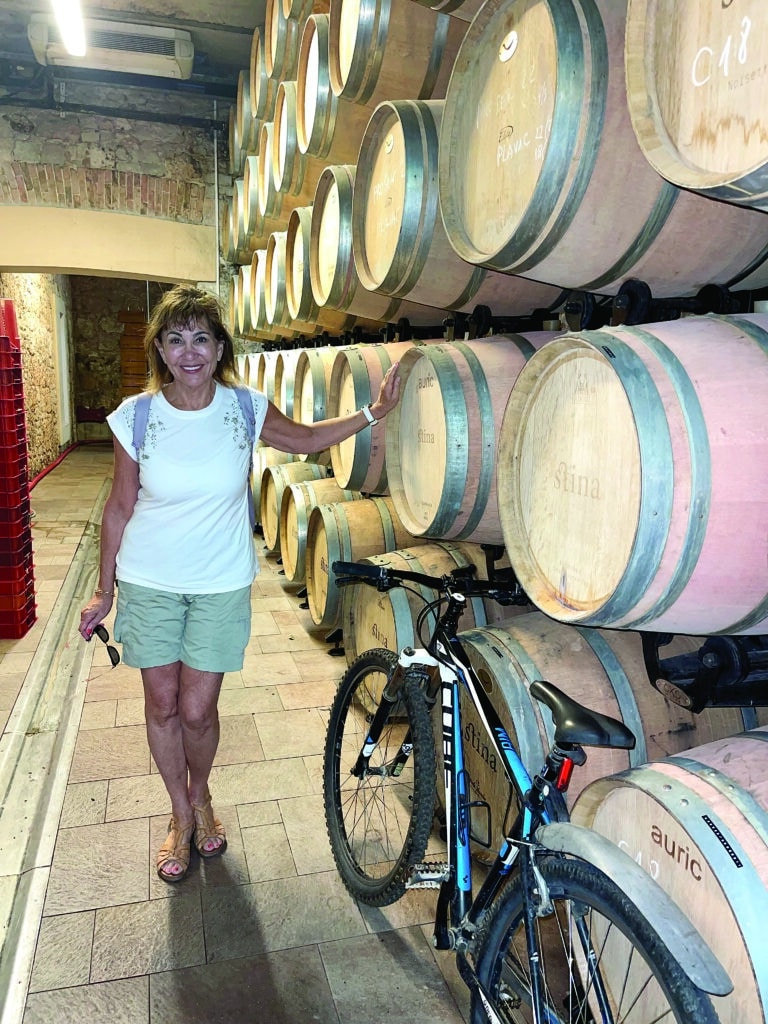
Inland Slavonia’s continental climate and fertile soil produce light, crisp, mildly aromatic white wines. The island of Krk is known for its dry white wines and domestic reds. Hvar produces fruity whites and bold reds.
Once she discovered this hole in the American wine scene and realized there was fun to be had in the world of wine distribution, her second career was born.
“I’ve always had a lot of business acumen. I love starting businesses, realizing where there are certain market niches to fill. I went from one type of medicine to another, in some respects,” Grbinich chuckled.
Grbinich Wine’s small, efficient staff covers sales, operations, deliveries, bookkeeping and advertising. The company seeks to satisfy retailers with the right price point and products for whatever customers request.
Building relationships
Though Grbinich holds a license to import international wines herself, this lady boss prefers to work closely with local importers concentrating on distribution to restaurants, wine boutiques, liquor stores and specialty European markets. Her product line has expanded to reflect the multicultural city of Atlanta and diverse communities like Gwinnett County.
Today, Grbinich is the largest distributor of Romanian wines in Atlanta. Wines from the Republic of Georgia, located at the intersection of Eastern Europe and West Asia, make up her second largest product by volume. Croatian wines comprise her third largest-selling category.
Curiosity and attentive customer service have Grbinich branching out to carry wines from all over the world, in addition to those from former Yugoslavia that started it all. The wines and spirits she stocks from other Balkan countries include products from Bulgaria, Bosnia, Serbia, Moldova and Ukraine. Vendors also demand wines from France, Italy, Turkey and South America.
In-person meetings keep Grbinich abreast of her customers’ needs. She relishes guiding them in their buying choices and customizing inventory to satisfy them. Hosting educational events and tastings on site or in her warehouse tasting room also proves to be beneficial for her retailers.
The price point of Grbinich Wines is approachable, with bottles retailing from $10 to $40.
“I try to purchase wines that are reasonable, especially in today’s economic climate. People are buying down. They want a fine Cabernet but instead of spending $30 for a bottle, they’re looking to spend $15 to $20,” Grbinich added.
Tastings
When it comes to wine degustation to familiarize customers with her exclusive products, Grbinich recommends a maximum of six: a mix of whites, rosés and reds.
“Everything will taste good after the sixth one, including Boone’s Farm,” she laughed.
Or one might choose to do a tasting of all reds, all whites or all dessert wines. “It’s easier for consumers to notice variations within one kind,” she said.
Training your palate to identify different notes of a wine, flavors and spices, is comparable to training your ear to hear different notes when you’re playing an instrument, according to Grbinich.
“Once you start on that journey, it’s really fascinating,” she smiled.

Don’t balk at trying Balkan Wines
You’ve never heard of Balkan wines? All the more reason to try them! With 2,500 years of wine production history, vehement vintners who’ve been perfecting their craft for centuries, taking great pride in maintaining European winemaking traditions and countless indigenous grape varieties, one would be amiss not to try these wines.
Whether you’re a wine aficionado or someone who appreciates an occasional glass with a nice meal, it would be a shame to limit your exposure to just a select few grape varietals commonly appreciated in the United States.
“You could probably name on one hand each of the reds and whites we customarily enjoy. In Europe, there are dozens of grape varietals that I was totally unfamiliar with and yet they’re so delicious, refreshing and pure,” Grbinich expounded.
Also worth highlighting are the health benefits of more organic, natural wines from small-scale, family-based European viniculture prioritizing a love of the land, immediate consumption and enjoyment of the fruits of the earth as they are harvested.
In contrast, millions of barrels of one varietal mass-produced in the United States necessitate manipulation and not-so-natural processes to preserve the wine.
Besides those seeking wines from their homelands, more and more Atlantans and residents of surrounding areas are craving something new.
Grbinich describes Atlanta as a “wine city,” evidenced by an explosion of wine boutiques. Coaxing people into testing their comfort zones and trying new vinos is Grbinich’s mission, “Life is too short to get stuck on one or two favorites!”

Difficult to say, delicious to drink
The most beloved red wine along the Adriatic Coast comes from a grape called Plavac Mali which is genetically linked to Zinfandel. Zinfandel, known as Tribidrag in Croatia, is thought to be a California born grape. However, it was introduced to California during the Gold Rush in the 1850s from Croatia.
Plavac Mali is known for producing flavorful, deep red wines ranging from medium to full-bodied, high in tannins, alcohol content and minerality resulting from rocky, coastal growing conditions. Its characteristic aromas span from sour cherry, red plum, licorice and spices to figs and dark berries.
If you like Zinfandel, you’ll love Dingac Plavac Mali, available upon request by retailers. Although most Croatian wines aren’t meant to be aged, Plavac Mali ages well.
Ukrainians make an incredible Cabernet: Stefania Cabernet Sauvignon. Find it at Buford Farmers Market. It’s full-bodied, aromatic and affordable.
Sauvignon Blanc fans would love fruity, Malvazija with its surprising floral aroma. Ask for Vina Laguna Malvasia from the Istrian peninsula at Corners Fine Wine and Spirits in Peachtree Corners.
Grbinich’s newest Piazza Mistrichi Italian Proseccos are coming soon to Italian restaurants with impeccable taste near you!
Do you fancy German pilsners? Try Romania’s Timișoreana, a golden, well-balanced lager with hop aroma dating back to 1718. Tower Beer, Wine & Spirits in Doraville carries it.
The stylishly packaged Hafner Premium X.O. brandy from Austria with notes of dark vanilla, caramel, molasses and a hint of tobacco is kosher, organic and vegan.
Break the rules and pick a wine you like! “If you want a red with your trout, that’s fine! If you want a nice white with a steak, it doesn’t matter. It’s your money,” Grbinich stated.
Cork or cap?
Nothing can replicate the ceremonial uncorking of a bottle of wine nor the popping perfection of that celebratory sound but contrary to popular belief, a cork doesn’t necessarily denote a higher quality bottle of wine, according to Grbinich, who carries both cork and screw cap bottles. In fact, since corks are porous, they can invite spoilage.
A twist top doesn’t require special equipment to open, so Grbinich finds them less intimidating. Plus, transporting an opened bottle is easier with a cap. Wineries are turning to screw caps and looking to make them more environmentally friendly.
Hobby to hustle
Grbinich’s formation included frequenting a number of wine schools to train her palate. Broadening her own knowledge of wines better enables her to guide others in enjoying them without insecurities. You don’t have to be a cork dork or understand the complex science behind winemaking in Grbinich’s view — it’s fine to simply enjoy it!
Related
Patrizia hails from Toronto, Canada where she earned an Honors B.A. in French and Italian studies at York University, and a B.Ed. at the University of Toronto. This trilingual former French teacher has called Georgia home since 1998. She and her family have enjoyed living, working and playing in Peachtree Corners since 2013.

Food & Drink
Four Peachtree Corners Restaurants Take Part in Gwinnett Burger Week
Published
2 months agoon
March 10, 2025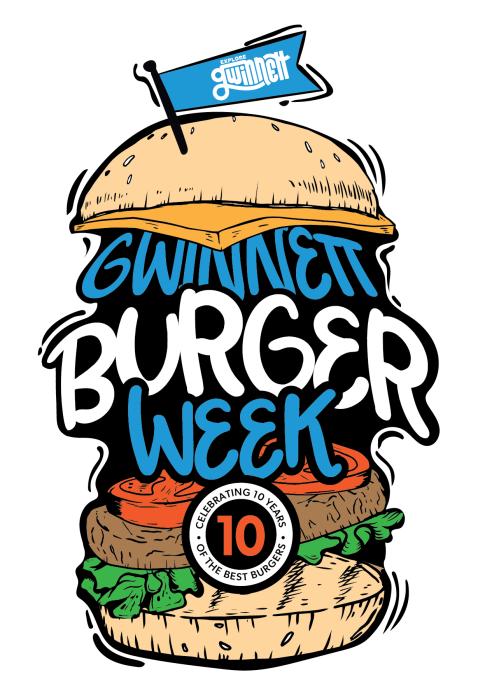
Explore Gwinnett celebrates a decade of culinary creativity with $10 chef-crafted burgers at 23 locally owned restaurants
Explore Gwinnett, the official tourism organization of Gwinnett County, is celebrating the 10th anniversary of its popular Gwinnett Burger Week. Making its anticipated return March 17–23, 2025, the event invites burger lovers to enjoy exclusive, chef-crafted creations for just $10 at 23 locally owned restaurants across the county.

“We are proud to celebrate a decade of Gwinnett Burger Week and the incredible talent of some of our very best local chefs,” said Lisa Anders, chief operating officer of Explore Gwinnett.
“What started as a way to highlight locally owned eateries has grown into a beloved tradition, and we cannot wait for the community to see what we have in store for them this year!”
Throughout the week, each of 23 participating restaurants will feature an exclusive, off-menu burger.
Peachtree Corners highlights include:
- “The Alma” at Marlow’s Tavern — a perfectly seasoned and grilled burger with salsa verde, pepper jack, fried jalapenos, avocado, tortilla strips, lettuce, tomato and onion on a buttered sesame brioche bun.
- “The Blue Flame” at LOL Burger Bar — a 5 oz. premium beef patty topped with homemade macaroni and cheese, pulled pork, blue cheese crumbles and the restaurant’s secret sauce to add a bit of spice.
- “Fired Up Burger” at Firebirds Wood Fired Grill — a wood-grilled burger, lettuce, tomato, pepper jack cheese, jalapeno bacon jam, fried onions and tangy mayo topped with fried pickles garnish.
- “K-BBQ Burger” at Stäge — an Angus beef smash burger with Korean BBQ glaze, roasted cheese corn, house-pickled veggies and gochujang mayo on a sesame brioche bun.
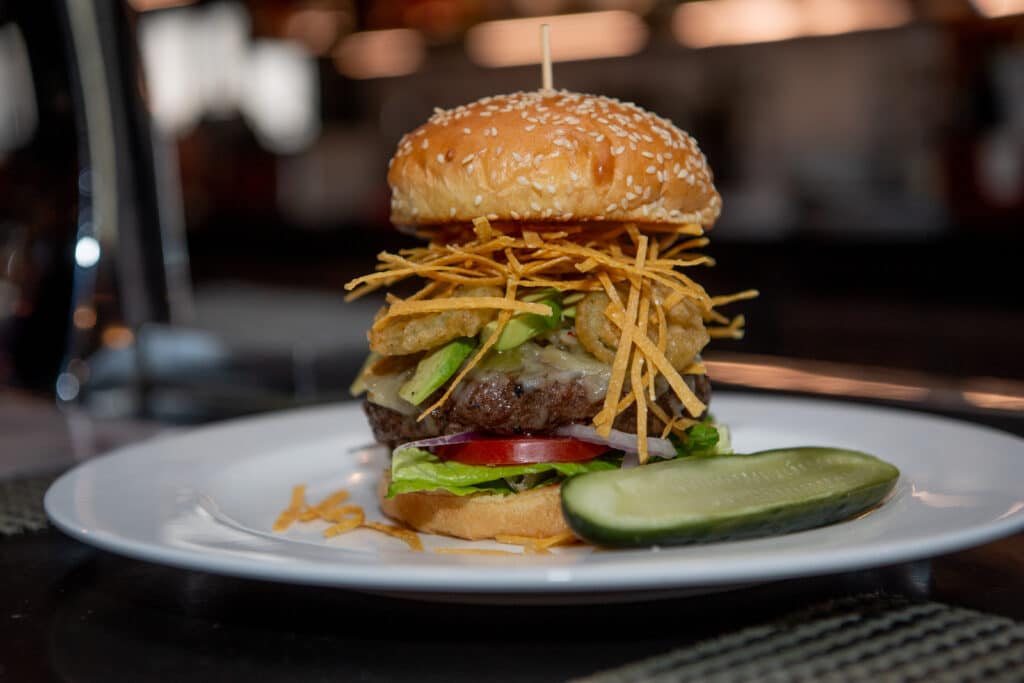
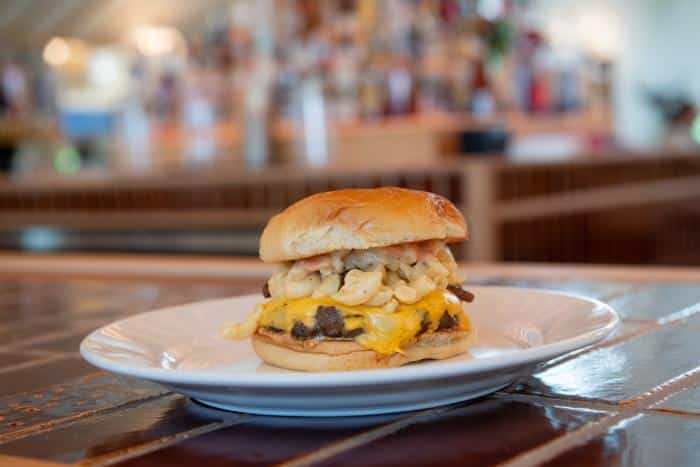
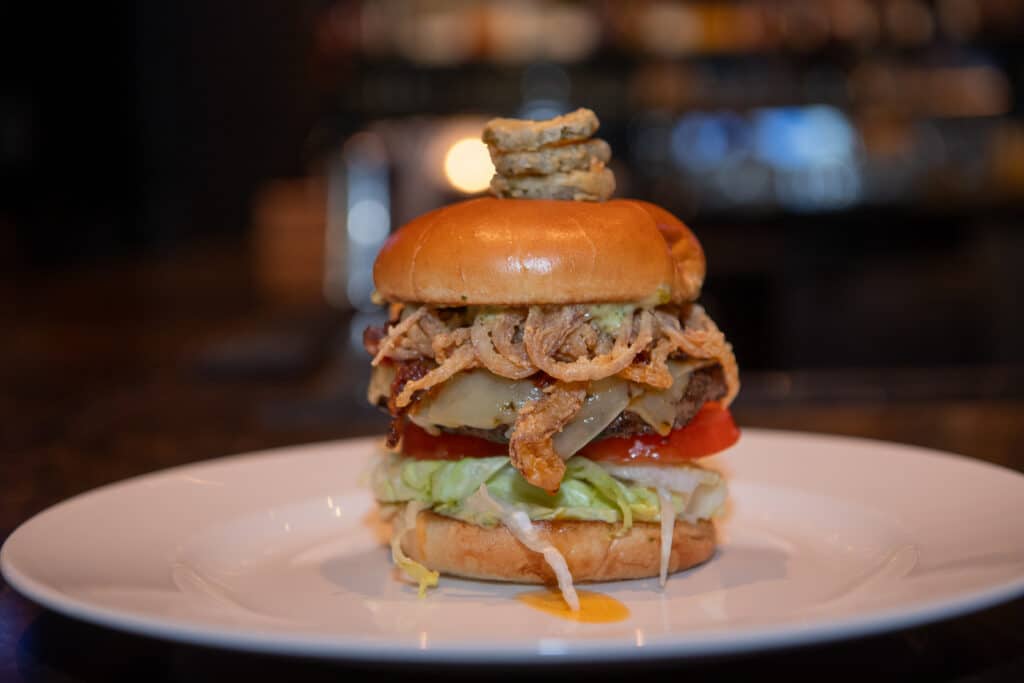
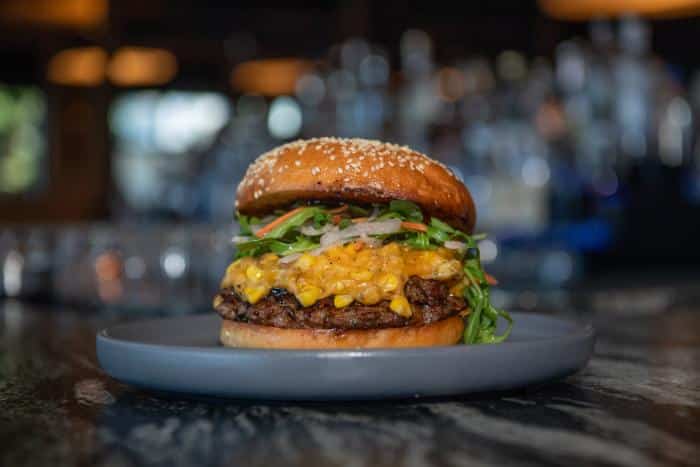
Gwinnett Burger Week digital pass
Back for its second year, the Gwinnett Burger Week Digital Pass encourages diners to check in at participating restaurants and earn points throughout the week, which are redeemable for prizes.
Each check-in is worth one point. Points can be redeemed for exclusive Gwinnett Burger Week merchandise from Explore Gwinnett, including restaurant gift cards, t-shirts, totes, sicker packs and a special edition 10th anniversary burger sticker designed by Lawrenceville-based artist Max Eve in celebration of this milestone.
Diners can also vote for their favorite burger by uploading an image of their receipt to the Gwinnett Burger Week website.
The Wall of Fame
Participants who track their dining experience at 10 or more restaurants throughout the week will be inducted into the Gwinnett Burger Week Wall of Fame with their photo published on Explore Gwinnett’s website.
“Our 10th anniversary milestone reflects the passion and creativity of Gwinnett County’s culinary community and the enthusiasm of all those who make this event a success year after year,” said Anders. “We can’t wait to indulge in the exclusive $10 burger creations ourselves, as we toast to 10 years of one of our favorite events!”
More details
To sign up for the Gwinnett Burger Week Pass, visit ExploreGwinnett.org/Gwinnett-Burger-Week/Burger-Week-Prize-Pass and provide the participant’s name, e-mail address and mobile phone number. A link will be sent to the participant’s phone, allowing them to access the pass and add the pass icon to their home screen.
For a full list of participating restaurants and limited-time burger offerings, visit exploregwinnett.org/gwinnett-burger-week.
Stay up-to-date on the latest Explore Gwinnett news by following @ExploreGwinnett on Instagram or ExploreGwinnett on Facebook. Diners are encouraged to share their experience on social media by using the hashtag #GwinnettBurgerWeek.
Related
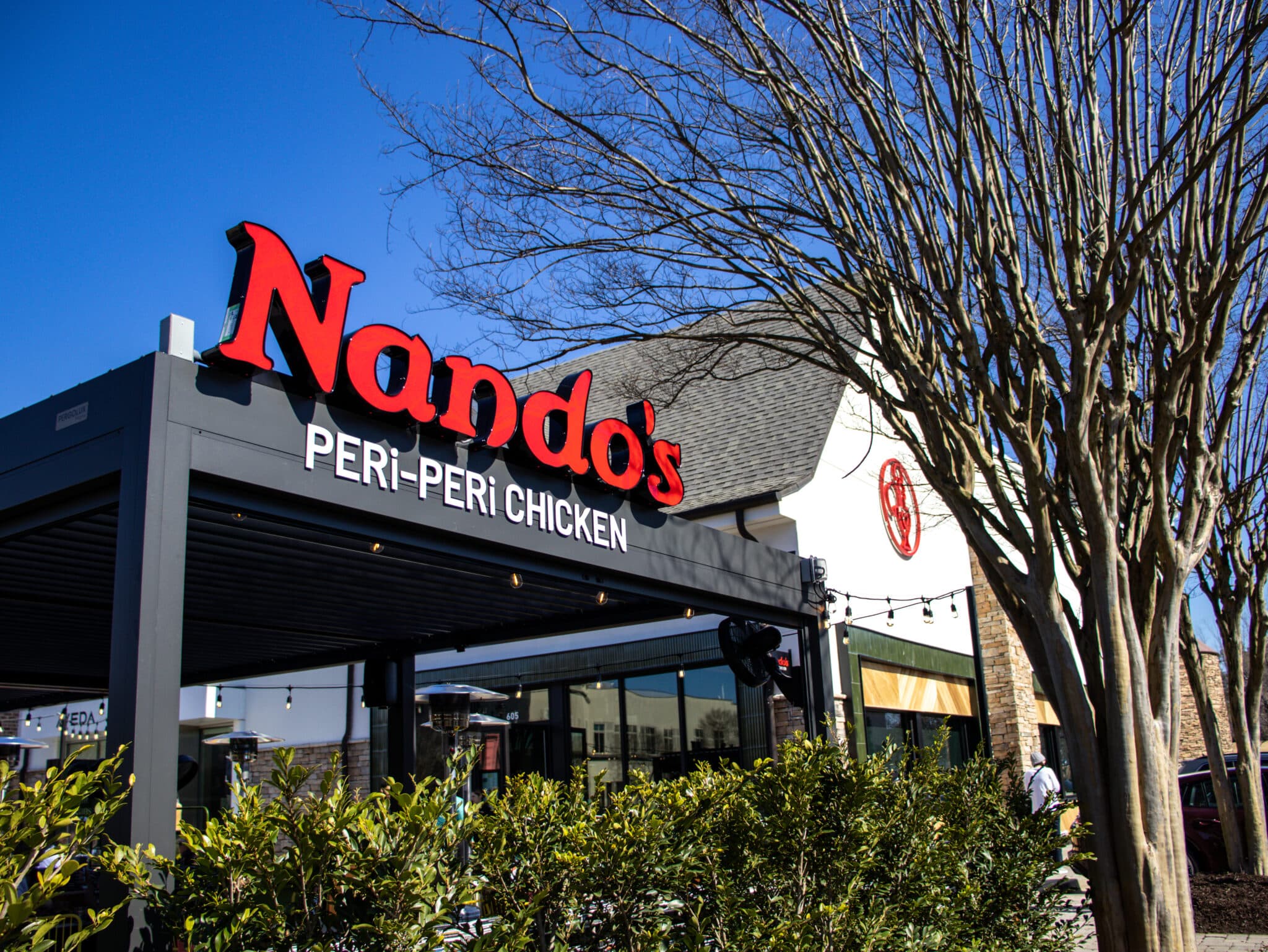
The South African fast-casual favorite expands in Georgia, bringing its signature flame-grilled spice and art-filled interiors to Peachtree Corners
Less than six months after opening its flagship Atlanta-area location at Perimeter’s High Street, world-famous South African restaurant brand Nando’s PERi-PERi opened its second Georgia restaurant to the public — for lunch and dinner service — on Tuesday, February 25.
Located within the premier mixed-used development and outdoor lifestyle center The Forum Peachtree Corners, Nando’s PERi-PERi is ready to offer its beloved flame-grilled chicken dishes, signature hot sauces and more to Atlanta-area locals and visitors alike.

“Atlanta has shown us so much love with the opening of our first location at High Street, so we couldn’t be more thrilled to expand our footprint in Georgia by bringing Nando’s to The Forum Peachtree Corners,” said Sepanta Bagherpour, chief brand officer at Nando’s PERi-PERi. “As a brand so rooted in community, we are excited to be a part of this lively hub where food, fun and connection unite.”
PERi-PERi flavor
Nando’s is known around the world for their flavorful flame-grilled chicken, and the concept’s popularity can be traced to PERi-PERi — or African Bird’s Eye Chili — the heart and soul of the Nando’s experience.
“We marinate our chicken in PERi-PERi for at least 24-hours, so the flavor goes right through to the bone,” Bagherpour explained. “Then we grill it over an open flame and baste it with PERi-PERi sauce to the customer’s preferred spice level. That’s what makes our chicken so addictive.”
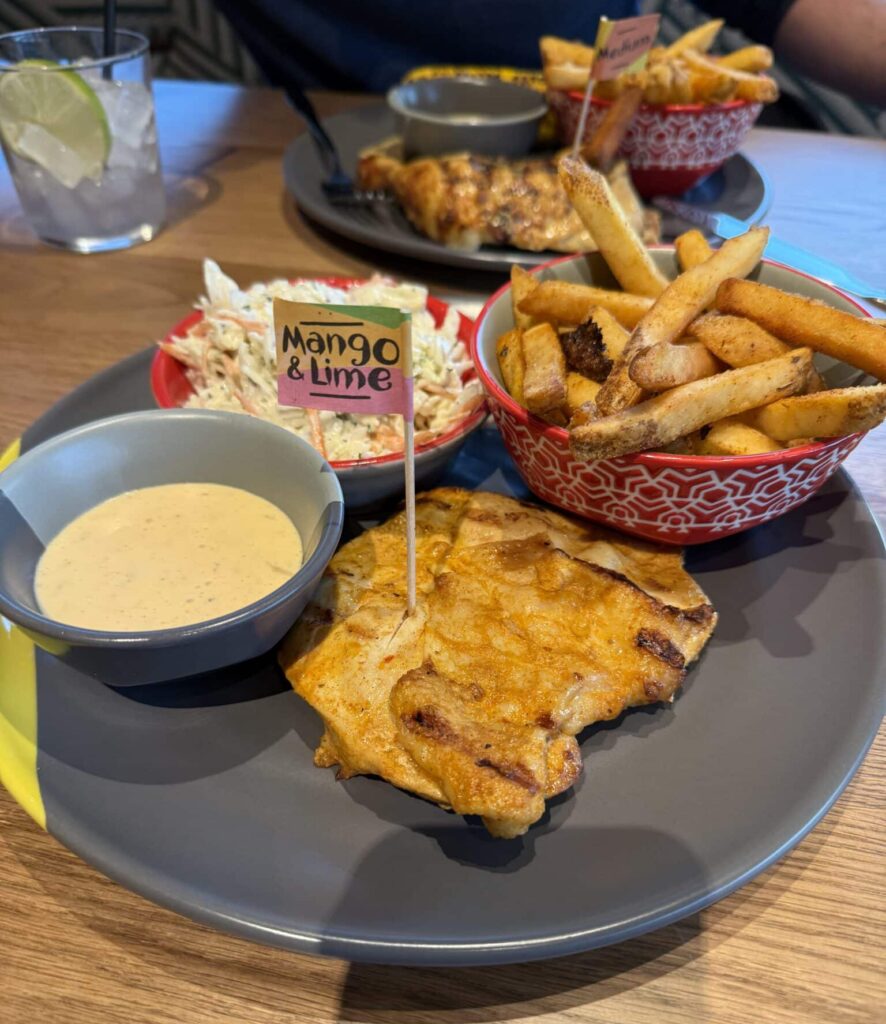
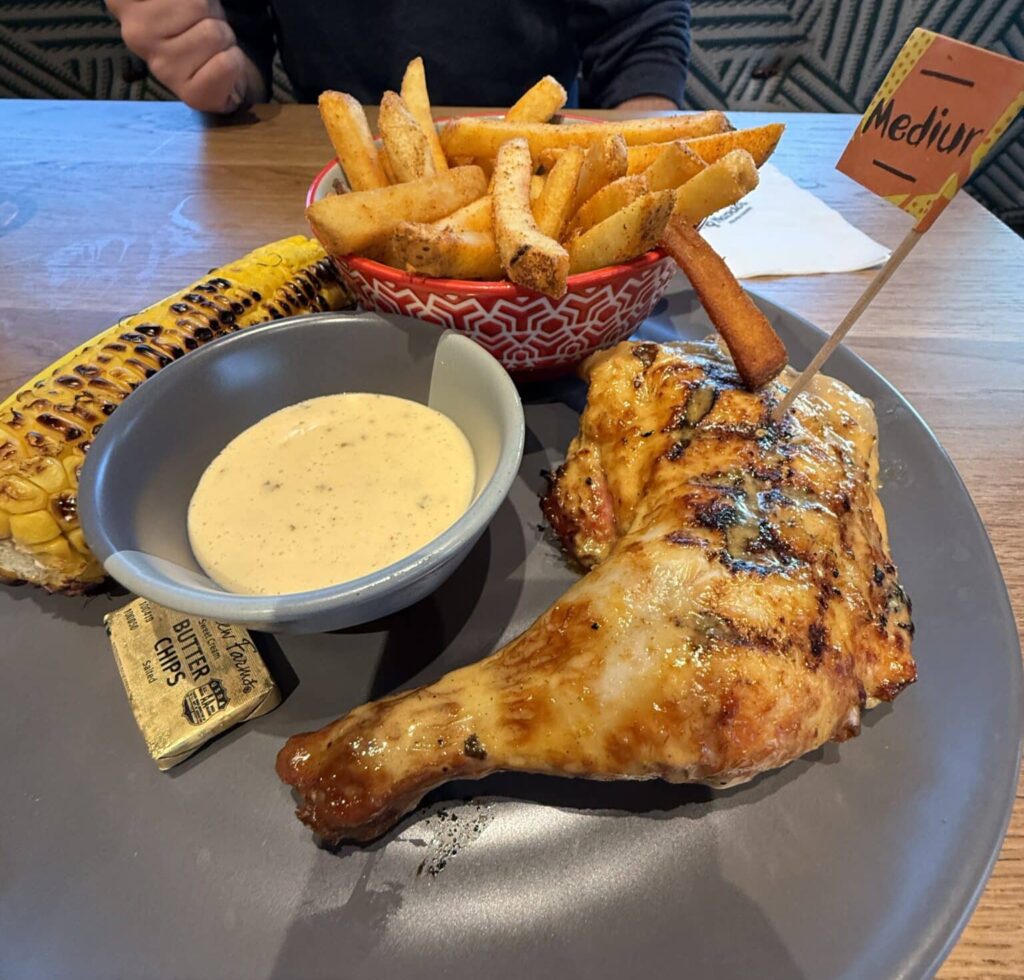
Nando’s sources its PERi-PERi in Mozambique, Zimbabwe, Malawi and South Africa via a network of 1,400 local farmers who are empowered with upfront access to funds, equipment and seedlings. And before the growing season even starts, they are guaranteed a fair price purchase commitment.
Warm space and friendly service
Nando’s intensely loyal following has not only been driven by its high-quality food, but also by its friendly service presented in a relaxed atmosphere that elevates the typical fine-fast casual experience.
Every Nando’s location is uniquely designed with earthy textures and vibrant colors that reflect its sunny African heritage while retaining a sense of place in which it lives and breathes.
The restaurant’s location in Peachtree Corners is no exception.

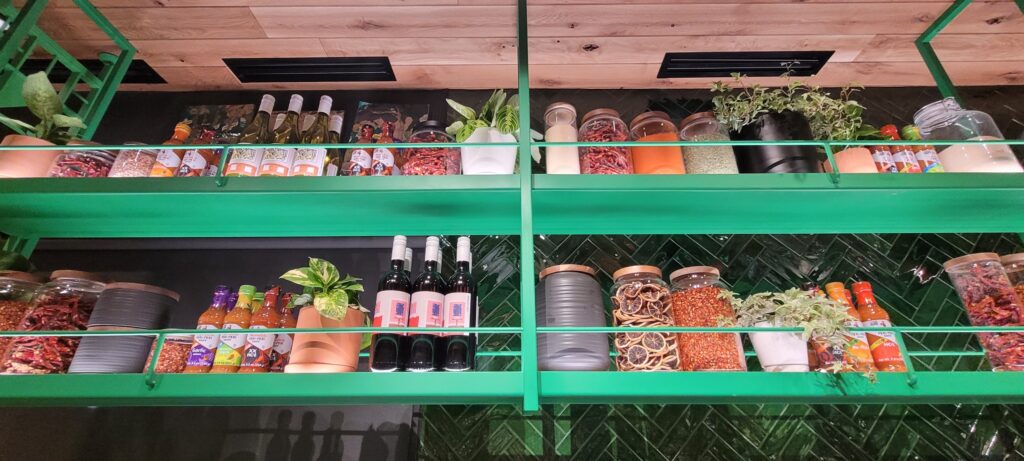

Designed by Fusion, Nando’s at The Forum is packed with custom lighting, furniture and authentic art imported from South Africa, showcasing the strong ties to its cultural heritage.
On a prominent corner within the newly refurbished open-air development, the new Nando’s visibility is boosted by its large, canopy-covered outdoor seating area. Inside the restaurant, guests will feel warm and welcome with design elements that balance the contrast of raw, textural finishes and saturated hits of color and pattern.
A great fit for The Forum
“As we continue energizing The Forum with new experiences for guests, Nando’s PERi-PERi stood out as an international favorite that would excite the community,” said Adam Schewgman, director and head of retail leasing at Jamestown. “From the inventive menu options to the meticulously selected design elements, we’re looking forward to giving visitors a taste of South Africa right here in Peachtree Corners.”
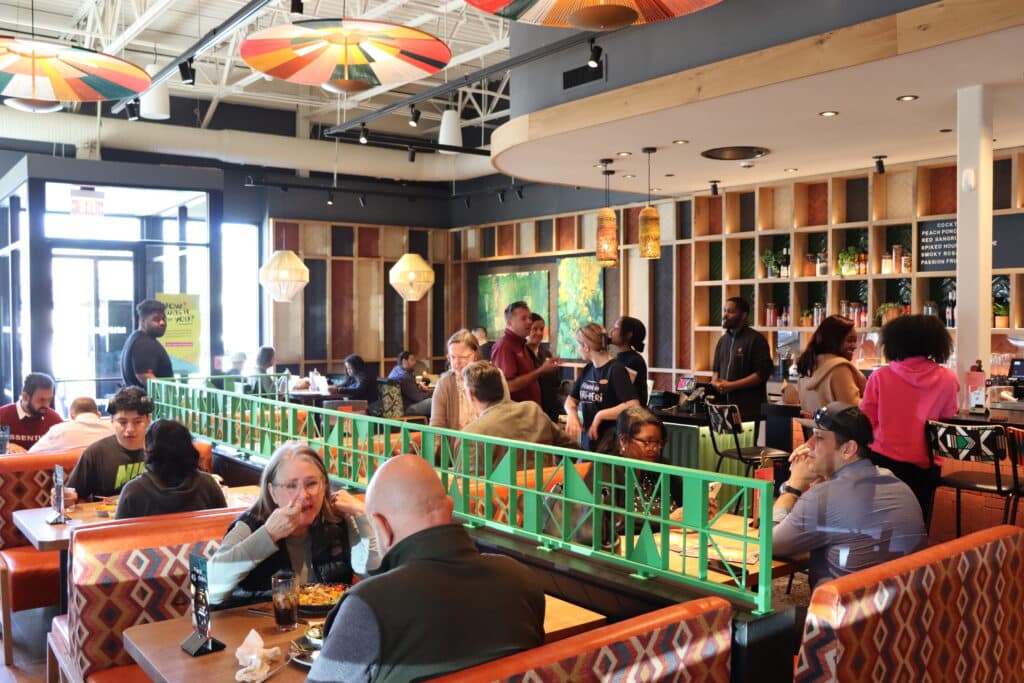
About Nando’s PERi-PERi
Since making its 1987 debut in Johannesburg, South Africa, Nando’s has spread its flame to legions of fans in 24 countries on five continents. The company entered the US market in 2008 with the opening of its first location in Washington, D.C., and now operates nearly 50 restaurants in and around Virginia, Maryland, Washington, Chicago, Texas and now Georgia.
For more information visit nandosperiperi.com or follow @nandosusa on Instagram.
Related
Food & Drink
Foodie Faves: Suburban Charm and Global Tastes in Peachtree Corners
Published
2 months agoon
February 25, 2025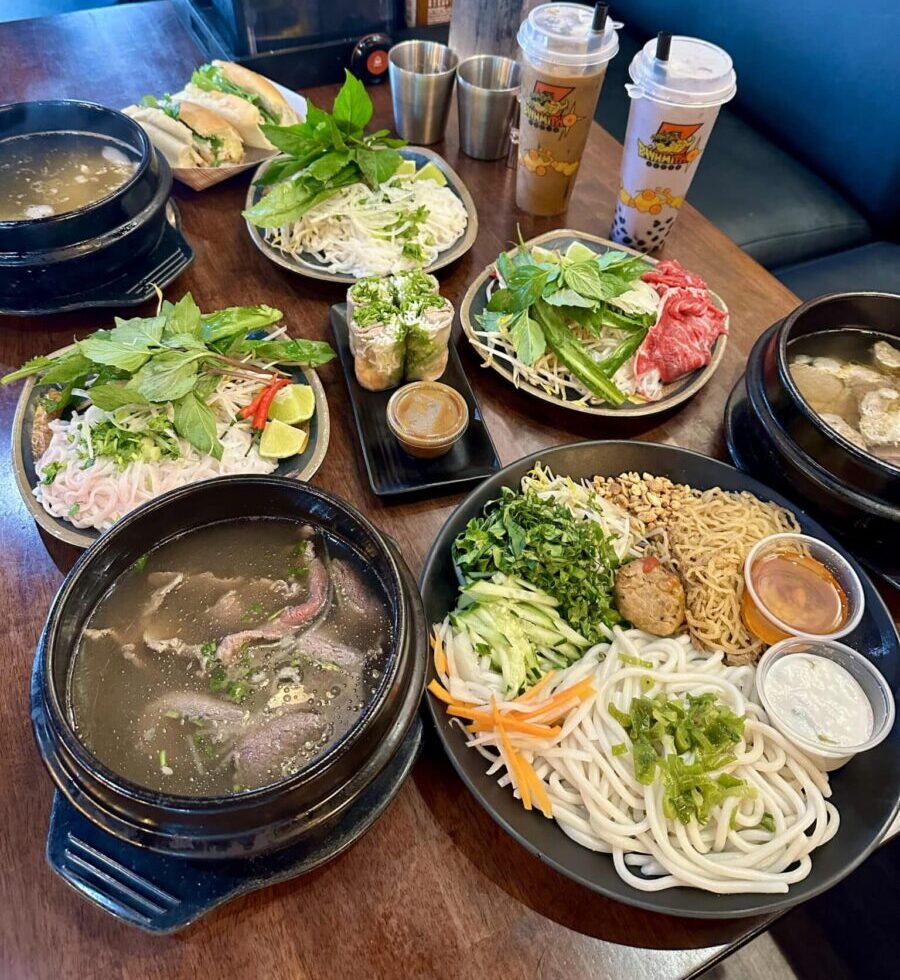
Metro Atlanta’s food scene is a tapestry of flavors, cultures and culinary creativity. Long known for its traditional Southern fare, recent years have also seen an increase in the number of restaurants — both independent and franchise — showcasing international, fusion or new South cuisines opening throughout the city.
While the busy food halls and trendy eateries in Midtown and Buckhead may get a lot of press, the northern suburbs, including Peachtree Corners, Norcross and Duluth, are experiencing a culinary Renaissance of their own.
Dozens of new and exciting restaurants have opened in Peachtree Corners over the last few years, with more planned for 2025.
Reflecting the eclectic tastes of a growing community, places like Stäge, H&W Steakhouse, and Fire & Stone Italian Pizza Kitchen have joined long-standing favorites such as J. Alexander’s and Taqueria del Mar in finding a following.
The upcoming scheduled openings of Golestan, Sei Ryu and the multi-restaurant lineup at The Forum’s new Politan Row has only added to the buzz around dining in Peachtree Corners.
With so many incredible places to choose from, figuring out where to enjoy your next lunch or dinner out can be a challenge. So, we turned to a few experts for help. And who knows the local food scene better than the influencers who get out, taste and share their thoughts on the latest and greatest spots in the city?
The following foodies answered the call to share some of their picks for must-try restaurants in Peachtree Corners and Norcross, with choices that offer something for just about every taste.
From Southern favorites to sushi, seafood, steak and more, these are a few of the local restaurants to check out — or revisit — in 2025.
Lena Ahn (@atlbestbites)

Dahlia’s Restaurant & Porch
One of Peachtree Corners newest restaurants, Dahlia’s Restaurant & Porch serves Southern American fare in the heart of the city. The setting is casual, and they often have live music in the evenings, which is a nice touch. They also have a beautiful patio, so be sure to dine outside when you can to truly enjoy the facilities.
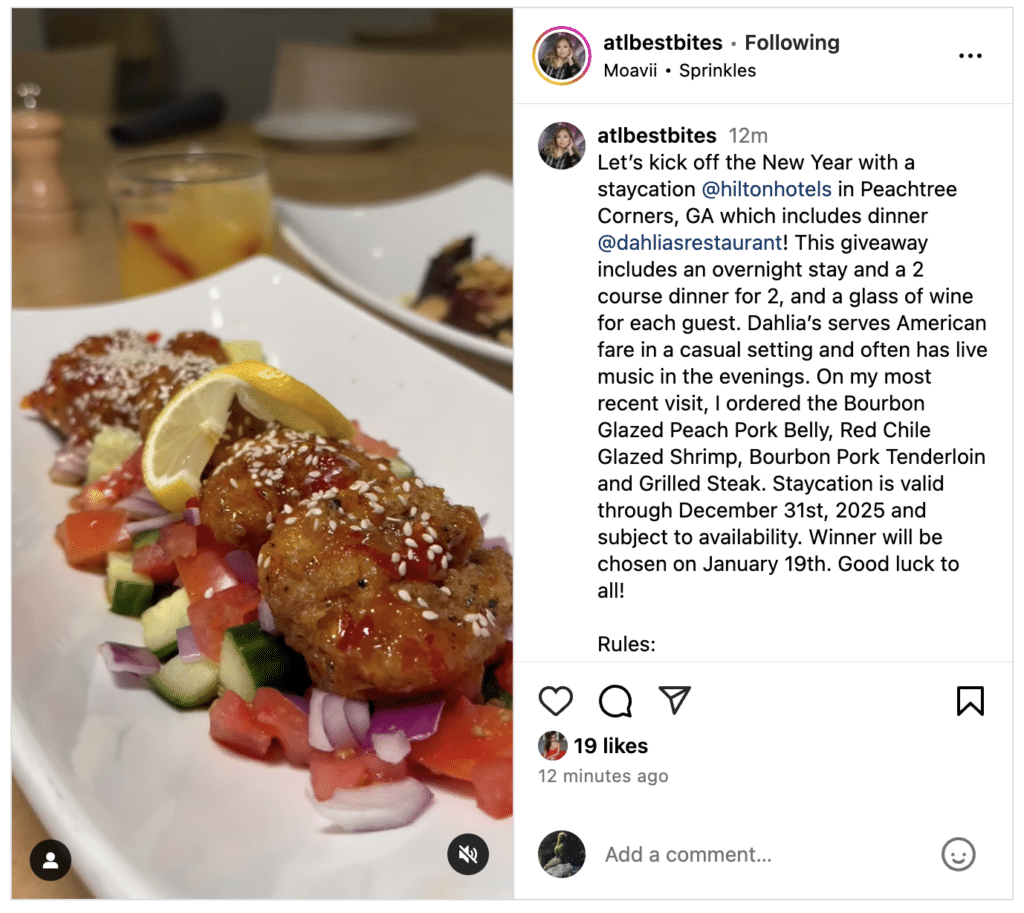
On my most recent visit, I ordered the Bourbon Glazed Peach Pork Belly, Grilled Steak, Red Chile Glazed Shrimp and Bourbon Pork Tenderloin. The shrimp was crispy and flavorful, and you can’t go wrong with steak!
Mai Le (@lemaitravel)

Stäge Kitchen & Bar
This was our third visit to Stäge Kitchen & Bar, and once again, it did not disappoint. The quality of the sushi here remains absolutely incredible. Every roll is fresh, flavorful and beautifully presented, showcasing the attention to detail that sets this place apart.
The consistency of the flavors and the impeccable service make it a standout spot. Whether you’re a sushi aficionado or just starting to explore Japanese cuisine, Stäge delivers an experience that keeps you coming back.
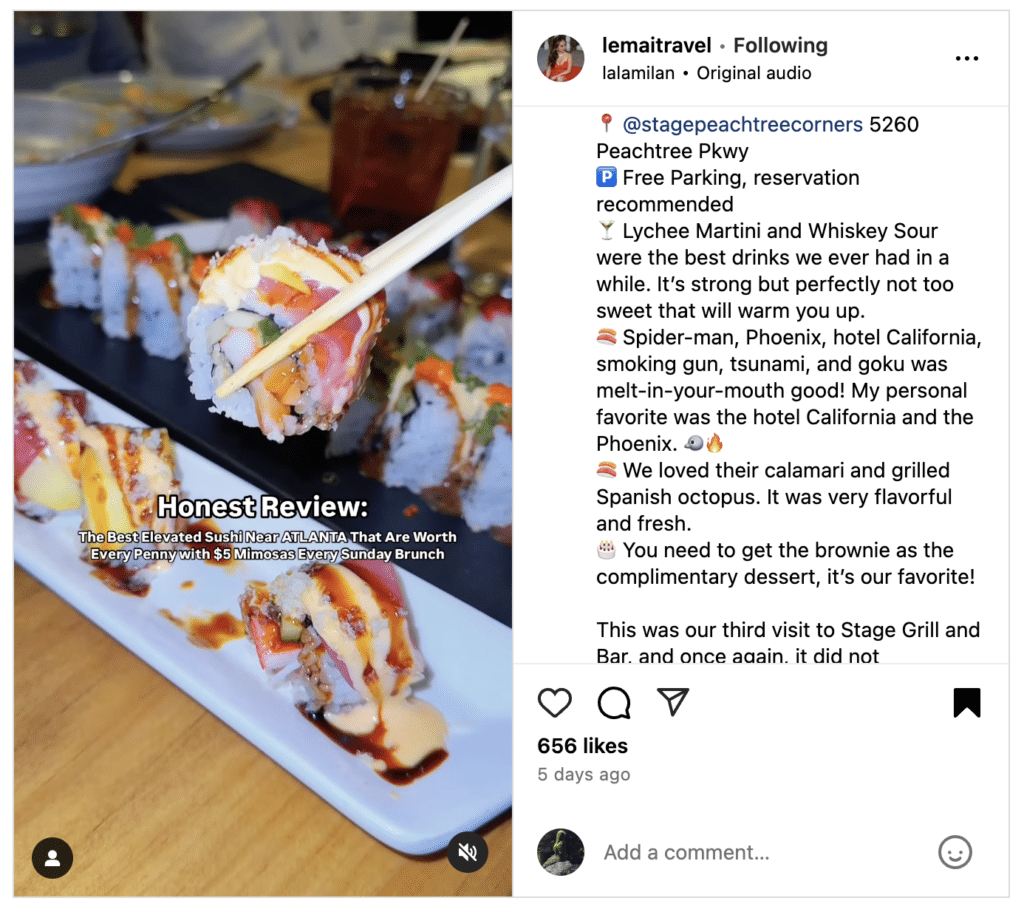
Highly recommend this gem for anyone seeking high-quality sushi in a welcoming atmosphere!
The Spider-man, Phoenix, Hotel California, Smoking Gun, Tsunami and Goku rolls were melt-in-your-mouth good! (My personal favorites were the Hotel California and the Phoenix.)
We loved their calamari and grilled Spanish octopus. Both were very flavorful and fresh.
The Lychee Martini and Whiskey Sour were the best drinks we’ve had in a while — strong but perfectly not-too-sweet that will warm you up.
And you need to get the brownie as the complimentary dessert; It’s our favorite!
Adam & Cole (@atlfoodiesofficial)

H&W Steakhouse
One of the BEST meals we had in 2023 and one of the best new restaurants we’ve dined at overall is hands down H&W Steakhouse in Peachtree Corners.
This stunning, fine-dining steakhouse is located 30 minutes outside of Atlanta and is one of the most beautiful restaurants we dined at [last] year.
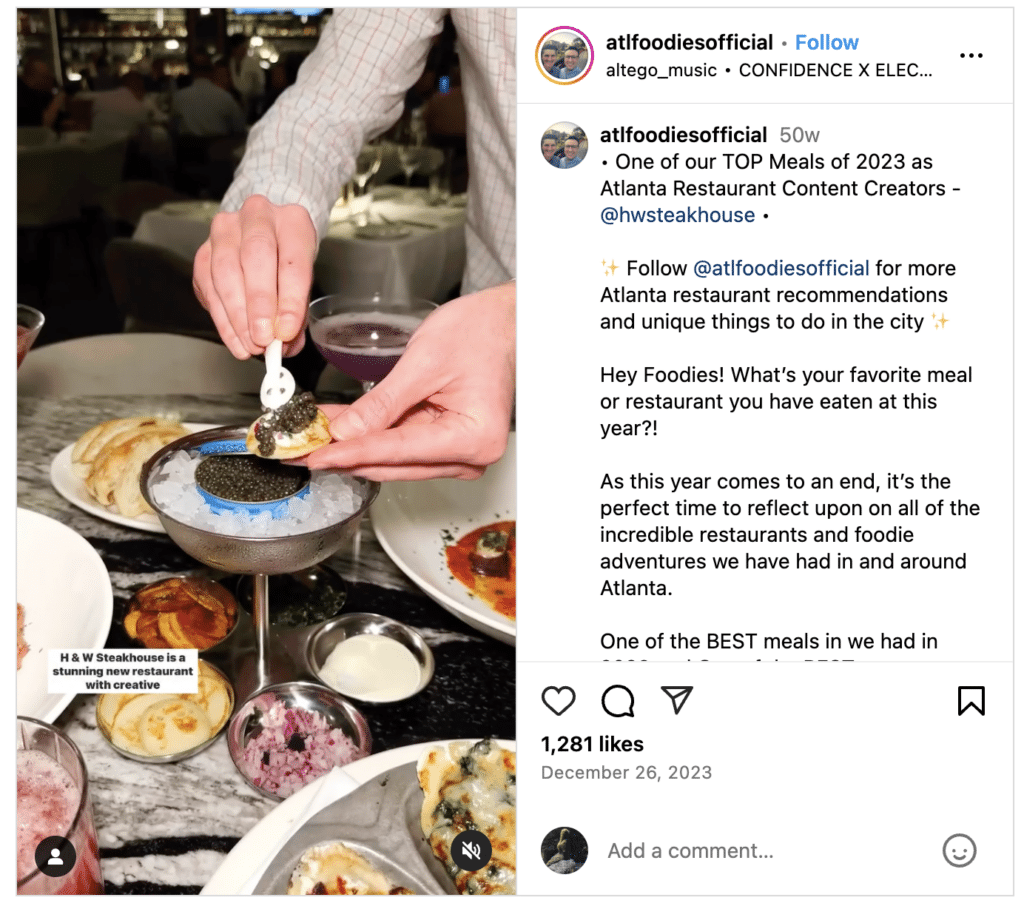
Serving everything from high-end steaks to luxury delicacies like caviar and A5 Japanese Wagyu, with over-the-top, tableside presentations, you will be absolutely blown away by your meal there.
You also have to end the meal with their famous Turtle Gelato Pie and Carajillo (a Spanish coffee cocktail made with espresso and liquor)! Both were absolutely phenomenal and a great way to end an amazing dinner.
Saadia Raja (@peachy_palate)

Pêche Modern Coastal
Good cheese needs good companions!
Our long overdue Girls’ Night Out led us to Pêche Modern Coastal where we had a cheesy good time.
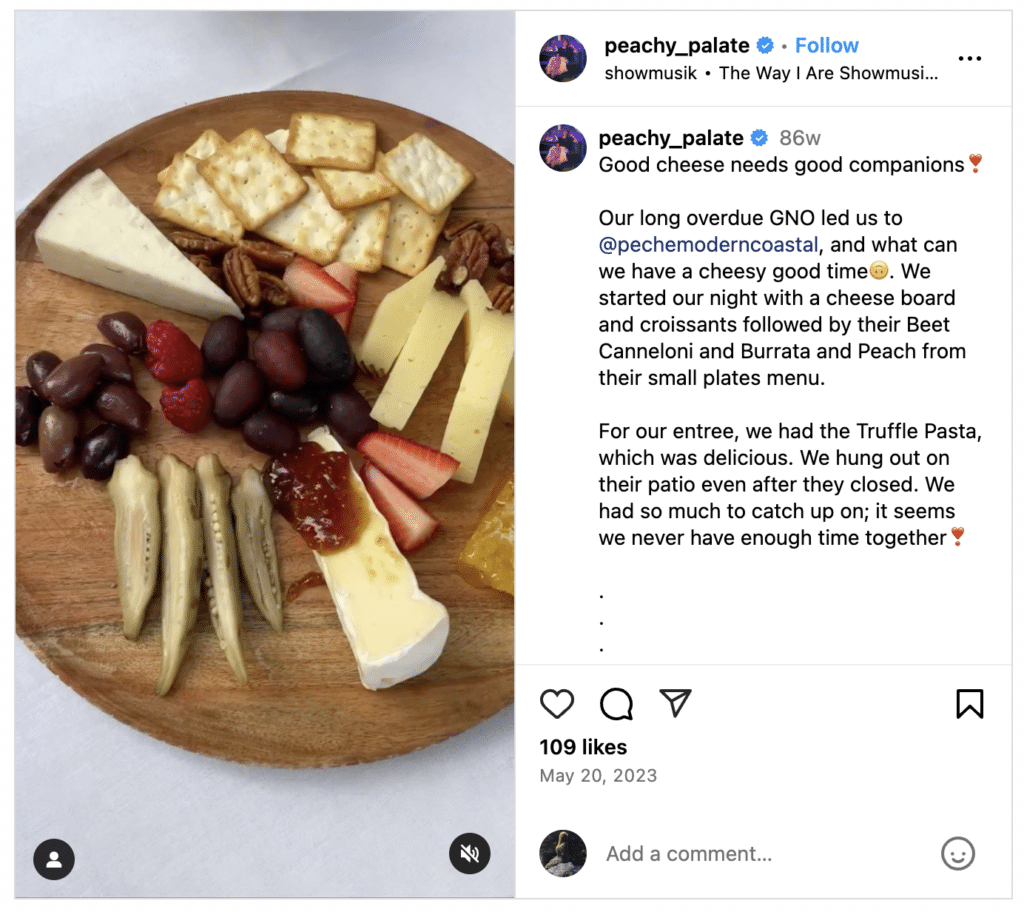
We started our night with a cheese board and croissants followed by the Beet Cannelloni and Burrata and Peach salad from their small plates menu.
For our entree, we had the Truffle Pasta, which was delicious.
I loved the patio at Pêche. We hung out [there] even after they closed. I can’t wait for spring and summer to come so I can enjoy it again.
Helen Dong (@_helenfoodie)

Super Banh Mi Pho
I finally got to try Super Banh Mi Pho, and I’m definitely coming back!
This Vietnamese restaurant has been on my list to try, and everything we got was so good! Some of my favorites are their banh mi and pho, which are made with fresh ingredients. The broth was so good, and adding in all the fresh ingredients made it taste even better!
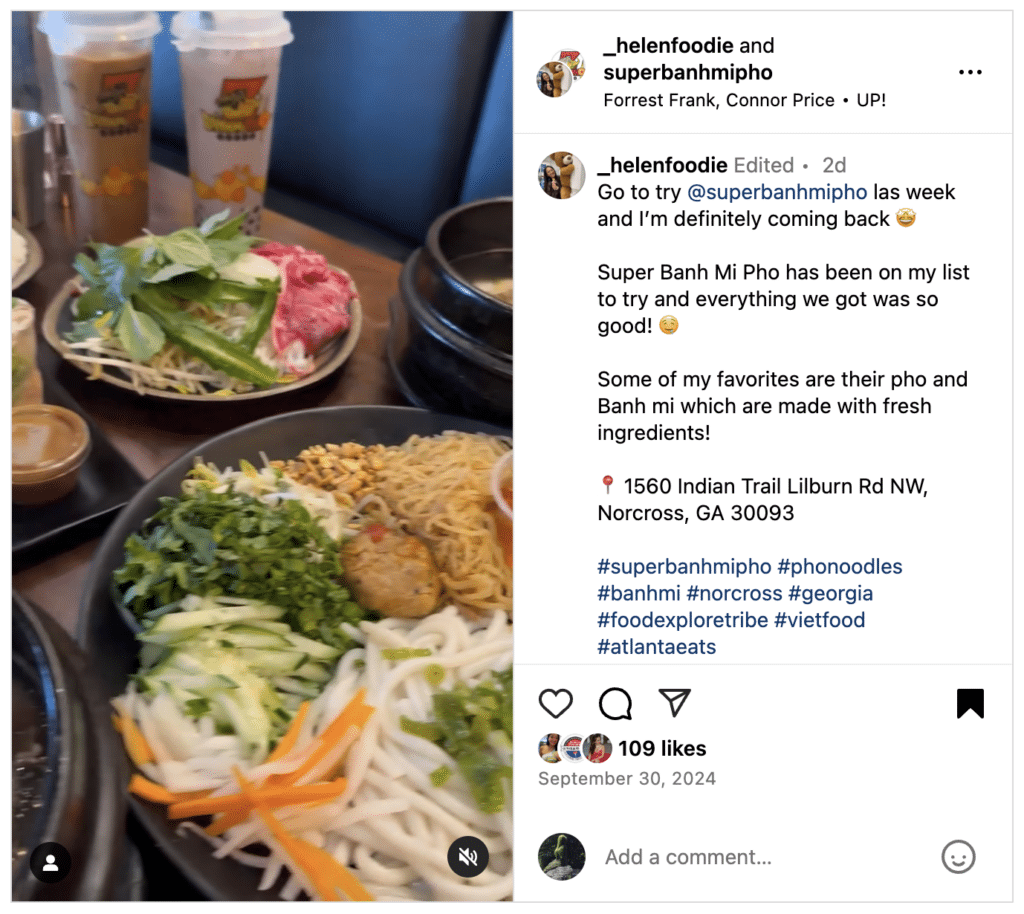
Editor’s note: Serving traditional Vietnamese dishes, the family-run Super Banh Mi Pho has developed a following among local foodies not just for its excellent food, but for its buzzworthy Dragon Ball Z décor, lively atmosphere and fun events.
This article originally ran in the February/March issue of Peachtree Corners Magazine. A digital edition of the publication can be found here.
Related
Read the Digital Edition
Subscribe
Keep Up With Peachtree Corners News
Join our mailing list to receive the latest news and updates from our team.
You have Successfully Subscribed!

GA Tech Launches First-of-its-Kind GT Atrium in Peachtree Corners

Katherine Lafourcade — A Journey of Passion, Resilience and Giving Back

Digital Edition

PCBA Announces 2025 Scholarship Winner

Paul Duke STEM High School Student Earns CGO Scholarship

World Blood Donor Day Starts Here: Theo’s Miracle, Katherine’s Mission [Podcast]

Peachtree Corners Grows Business Opportunities Through Economic Development

Official City Merchandise Line Debuts This Saturday at Town Green

Simpson Elementary Marks Exceptional Children’s Week

Executive Function: A Tribute to Working Moms

Official City Merchandise Line Debuts This Saturday at Town Green

Peachtree Corners Grows Business Opportunities Through Economic Development

Digital Edition

World Blood Donor Day Starts Here: Theo’s Miracle, Katherine’s Mission [Podcast]

Paul Duke STEM High School Student Earns CGO Scholarship

PCBA Announces 2025 Scholarship Winner

Light up the Corners [Video]

Capitalist Sage: Business Leadership in Your Community [Podcast]

Cliff Bramble: A Culinary Adventure through Italy

Top 10 Brunch Places in Gwinnett County

A Hunger for Hospitality

THE CORNERS EPISODE 3 – BLAXICAN PART 1

Top 10 Indoor Things To Do This Winter

The ED Hour: What it takes to Remove Barriers from Education

Peachtree Corners Life
Topics and Categories
Trending
-
Digital Edition5 days ago
Digital Edition
-
Podcast5 days ago
World Blood Donor Day Starts Here: Theo’s Miracle, Katherine’s Mission [Podcast]
-
Business3 days ago
Peachtree Corners Grows Business Opportunities Through Economic Development
-
City of Peachtree Corners3 days ago
Official City Merchandise Line Debuts This Saturday at Town Green








